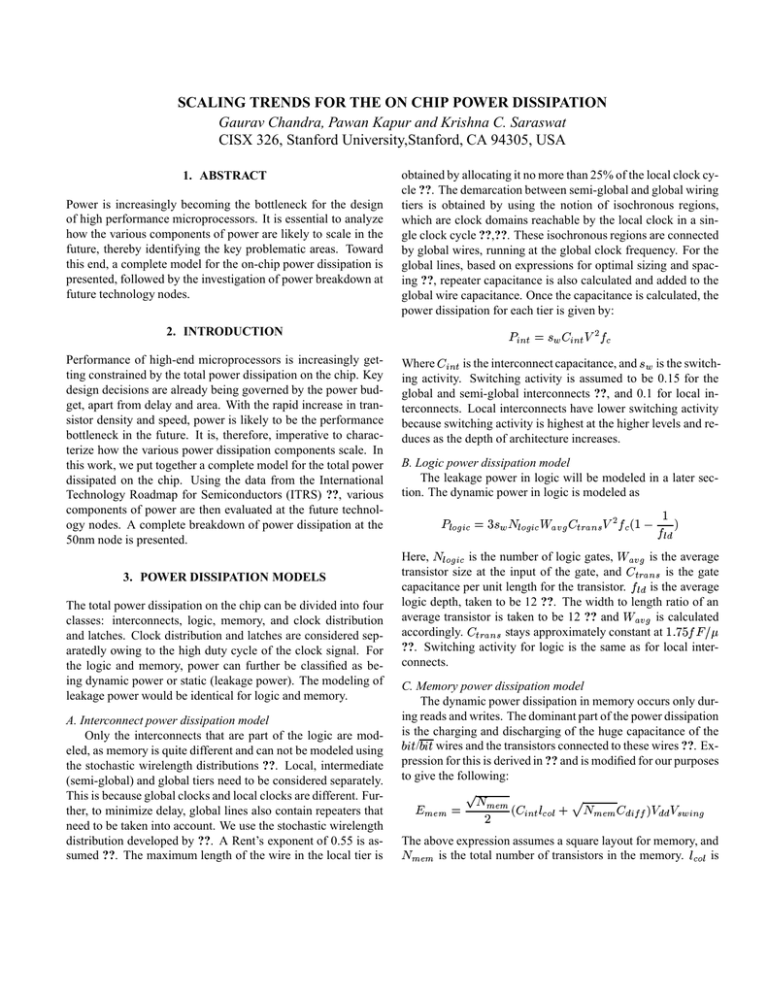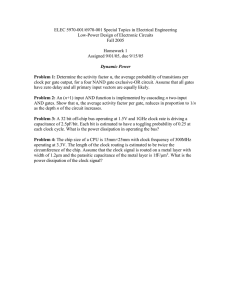SCALING TRENDS FOR THE ON CHIP POWER DISSIPATION
advertisement

SCALING TRENDS FOR THE ON CHIP POWER DISSIPATION
Gaurav Chandra, Pawan Kapur and Krishna C. Saraswat
CISX 326, Stanford University,Stanford, CA 94305, USA
1. ABSTRACT
Power is increasingly becoming the bottleneck for the design
of high performance microprocessors. It is essential to analyze
how the various components of power are likely to scale in the
future, thereby identifying the key problematic areas. Toward
this end, a complete model for the on-chip power dissipation is
presented, followed by the investigation of power breakdown at
future technology nodes.
obtained by allocating it no more than 25% of the local clock cycle ??. The demarcation between semi-global and global wiring
tiers is obtained by using the notion of isochronous regions,
which are clock domains reachable by the local clock in a single clock cycle ??,??. These isochronous regions are connected
by global wires, running at the global clock frequency. For the
global lines, based on expressions for optimal sizing and spacing ??, repeater capacitance is also calculated and added to the
global wire capacitance. Once the capacitance is calculated, the
power dissipation for each tier is given by:
2. INTRODUCTION
Performance of high-end microprocessors is increasingly getting constrained by the total power dissipation on the chip. Key
design decisions are already being governed by the power budget, apart from delay and area. With the rapid increase in transistor density and speed, power is likely to be the performance
bottleneck in the future. It is, therefore, imperative to characterize how the various power dissipation components scale. In
this work, we put together a complete model for the total power
dissipated on the chip. Using the data from the International
Technology Roadmap for Semiconductors (ITRS) ??, various
components of power are then evaluated at the future technology nodes. A complete breakdown of power dissipation at the
50nm node is presented.
3. POWER DISSIPATION MODELS
The total power dissipation on the chip can be divided into four
classes: interconnects, logic, memory, and clock distribution
and latches. Clock distribution and latches are considered separatedly owing to the high duty cycle of the clock signal. For
the logic and memory, power can further be classified as being dynamic power or static (leakage power). The modeling of
leakage power would be identical for logic and memory.
A. Interconnect power dissipation model
Only the interconnects that are part of the logic are modeled, as memory is quite different and can not be modeled using
the stochastic wirelength distributions ??. Local, intermediate
(semi-global) and global tiers need to be considered separately.
This is because global clocks and local clocks are different. Further, to minimize delay, global lines also contain repeaters that
need to be taken into account. We use the stochastic wirelength
distribution developed by ??. A Rent’s exponent of 0.55 is assumed ??. The maximum length of the wire in the local tier is
Where
is the interconnect capacitance, and
is the switching activity. Switching activity is assumed to be 0.15 for the
global and semi-global interconnects ??, and 0.1 for local interconnects. Local interconnects have lower switching activity
because switching activity is highest at the higher levels and reduces as the depth of architecture increases.
B. Logic power dissipation model
The leakage power in logic will be modeled in a later section. The dynamic power in logic is modeled as
!"$#&%(')&*,+-'./ 0132
# 1
465
% '.)&
Here,
is the number of logic gates, 7,+-'is
"/ the average
transistor size at the input of the gate, and
is the gate
4
capacitance per unit length for the transistor.
is the average
logic depth, taken to be 12 ??. The width to%8length
'.)& ratio of an
average transistor is taken to be 12 ?? and
is calculated
*,+&'/
1"9;:<6=?>@
accordingly.
stays approximately constant at
??. Switching activity for logic is the same as for local interconnects.
C. Memory power dissipation model
The dynamic power dissipation in memory occurs only during reads and writes. The dominant part of the power dissipation
is
ABDC the
A&BEC charging and discharging of the huge capacitance of the
/ wires and the transistors connected to these wires ??. Expression for this is derived in ?? and is modified for our purposes
to give the following:
FHG3IJGKML
# 3
G IJG
0O P,JRQ
S #TG7IGU 4& VV 44 /JW
5
N
The
expression assumes a square layout for memory,
P Jand
# G3IJabove
G
is the total number of transistors in the memory.
is
the H-tree network is derived to be
1 \
N 5 5
3
*`?a ,+ IIH
!b 01H2c0
b
is the edge-length of logic area, and
is the capacitance
per unit length for the global wire. d depends on the number of
spine location to be driven by the H-tree and is given as
#h/Oij I
Fig. 1. Grid based clock distribution, assumed in this work
d
POef g0 #h/Oij I 2k1
5
In this case,
, the number of spine locations, is the same
as the number of isochronous regions.
The buffer capacitance for the H-tree depends on the final
load, which is the capacitance of the grid and the latches. For
a width ratio of 4, for optimum delay ??, the buffer capacitance
for the H-tree is given by
lDm V n0O +o 47Q '&gJp
the column height, which is the square root of memory area in
this case. Memory area is calculated from layout conderations
4& VV
of the memory, assuming about X"YY"Z per memory cell.
is the diffusion capacitance of one memory transistor.
The power dissipated is calculated assuming one instruction
per cycle, and the fact that approximately 30% of all data instructions are memory operations, resulting in 1.3 memory instructions per cycle ??.
D. Leakage power dissipation model
For the leakage power calculation, total leakage current is
calculated based on the ITRS projections for transistor leakage
current per unit width. The expression for the static leakage
power is given by
[ I '.\.'& I ]%(')&^ I '.\#,+&'/_44
^ I '.\
% '.)&
Where
is the leakage current per unit width, and
is
# ,+-'./
as defined above.
is the total number of transistors, taken
separately for logic and memory.
E. Clock power dissipation model
Depending on skew objectives, there are a number of clock
distribution schemes. The least expensive in terms of power, but
with most skew, is the H-tree based clock distribution scheme.
Most agressive is a complete grid based clock distribution of the
Alpha microprocessors that achieves low skews even with nonuniform loading ??. We consider an H-tree based distribution
for the global clock is then followed by a grid based distribution for the local clock. A schematic for this clock distribution
scheme is shown is Figure 1.
The global clock distribution capacitance has two components: the wiring capacitance for the global H-tree, and the capacitance of the clock tree buffers. The wiring capacitance of
qsrOtuovJw 1 }|
x
0
9 !"!~0D +-4Q 'gJp
5 yWz {$5
5
Y
The total power dissipation in the global clock distribution is
sD-J\ & l '0O `?a ,+ II Q lOm V 4 4 & l '
5
In a typical design, for a desired clock skew, grid dimensions
are dictated by the non-uniformity of the load. However, it has
been observed that a typical grid wiring density of 3-6% of one
entire intermediate wiring layer achieves the desired skew ??.
We compute the grid wiring area based on a round figure of 5%.
Grid pitch is assumed to be the intermediate wiring pitch. The
latch capacitance is calculated as
*'&gJph0
1
465
%(')&#&*,+&'/
The formulation is similar to the one used for power dissipation
in logic. The total clock distribution power is evaluated as
$D-J\sD-J\ & l '& Q &+- 4 Q ['&gJp
4. RESULTS AND DISCUSSION
Figure 2 shows the histogram of the various power components
at future technology nodes. ITRS projections for the total chip
budget is also plotted for reference. It is seen that clock distribution alone runs into more than 250W at the 50nm technology
node, and is likely to be the most serious problem unless innovative schemes are applied. The power dissipation in logic gates
alone also exceeds the ITRS chip budget. Other components,
though overshadowed by above two, are also getting larger. To
get an idea of how the components scale in terms of their fractional contribution, we plot the breakdown of power at the 50nm
technology node in Figure 3. Figure 4 shows the breakdown at
the present technology node, for comparison.
1000
300
900
250
200
Total chip Power dissipation (Watts)
Repeaters
Glboal lines
Semiglobal lines
Local lines
Logic
Memory
Clock
ITRS projections for total power dissipation on chip
150
100
Estimated power dissipation
ITRS projections
800
700
600
500
400
300
200
100
50
0
0
1998
1
2
3
4
5
6
7
8
2000
2002
2004
2006
Year
2008
2010
2012
9
Fig. 5. Estimation of total chip power, and comparison with ITRS
projections
Fig. 2. Scaling of various power components in the future
Repeaters
Global lines
Semiglobal lines
4%
4%
4%
Clock
Local lines
15%
33%
Logic (leakage power)
<1%
4%
29%
7%
Memory (leakage power)
It is seen that the percentage of dynamic power dissipated
in the logic increases, at the cost of interconnect power going down. Most other components do not change significantly.
However, it might be wrong to infer that interconnects would
not be a problem, since in absolute numbers the interconnect
power dissipation also increases significantly.
Figure 5 plots the total power dissipation, comparing with
the ITRS projections. The estimated power dissipation soon
grows to exorbitant proportions. Thus, unless the design methodologies undergo lots of changes, power dissipation is likely to be
a very serious problem, reaching unmanageable limits.
Memory (dynamic power)
Logic(dynamic power)
5. CONCLUSION
Fig. 3. Breakdown of power in year 2011 (50nm technology node)
Global lines Repeaters
Semiglobal lines
3%
3%
6%
Clock
A complete model for the on-chip power dissipation is presented,
followed by theanalysis of scaling of various components of
power. It is seen that clock distribution and dynamic power dissipation in the logic are the two most important entities, though
the power dissipation of other components is, by no means,
small. As a result, the total power dissipation of the chip would
far exceed the ITRS projections unless innovative design methodologies are adapted.
38%
Local lines
30%
13%
7%
Memory (dynamic power)
Logic (dynamic power)
Memory (leakage power)
< 1%
Fig. 4. Breakdown of power at the present technology node
[1] International Technology Roadmap for Semiconductors, 1999
[2] Davis et al, A stochastic wirelength distribution for GSI Integration,
blah blah
[3] BACPAC
[4] Computer Architecture: A Quantitative Approach, Henessy and
Patterson
[5] Bailey et al, Clocking Design and Analysis for a 600MHz Alpha
Microprocessor, IEEE JSSC, Nov. 1998
[6] Liu et al, Power Consumption Estimation in CMOS VLSI Chips,
IEEE JSSC, June 1994


